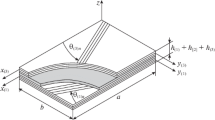Abstract
In this paper, a mathematical model is suggested for decaying vibrations of laminated plates formed by a finite number of arbitrarily oriented orthotropic viscoelastic layers of polymer composites arranged into an anisotropic structure with a layer of stiff isotropic viscoelastic material applied on one of its outer surfaces. The model is based on the Hamilton variation principle, the refined Mindlin–Reissner theory for plates, and the elastic–viscoelastic correspondence principle of the linear viscoelasticity theory. In the description of the physical relationships between the materials of the layers forming structural orthotropic polymeric composites, the influence of vibration frequency and ambient temperature is assumed to be negligible, whereas for the stiff viscoelastic polymeric layer, the dependence of elastic dissipation and stiffness properties on temperature and frequency is considered by means of experimentally determined generalized curves. Equations of motion are obtained for the Timoshenko beam with a layer of stiff isotropic viscoelastic polymer on one of its outer surfaces as a specific case of the general problem by neglecting mid-surface strain in the direction of one of the plate axes. Minimization of the Hamiltonian makes it possible to describe the decaying vibrations of anisotropic structures with an algebraic problem of complex eigenvalues. A system of algebraic equations is formed by the Ritz method using the Legendre polynomials as coordinate functions. First, the real solutions are obtained. To derive complex natural frequencies of the system, the obtained real natural frequencies are taken as the input values, and the complex natural frequencies are calculated applying the third-order iteration method.
Similar content being viewed by others
References
R. F. Gibson, “Dynamic mechanical properties of advanced composite materials and structures: A review,” Shock Vib. Dig. 19 (7), 13–22 (1987).
B. Benchekchou, M. Coni, H. V. C. Howarth, and R. G. White, “Some aspects of vibration damping improvement in composite materials,” Composites, Part B 29, 809–817 (1998).
R. Chandra, S. P. Singh, and K. Gupta, “Damping studies in fiber-reinforced composites—A review,” Compos. Struct. 46, 41–51 (1999).
I. C. Finegan and R. F. Gibson, “Recent research on enhancement of damping in polymer composites,” Compos. Struct. 44 (2–3), 89–98 (1999).
A. Treviso, B. Van Genechten, D. Mundo, and M. Tournour, “Damping in composite materials: Properties and models,” Composites: Part B 78, 144–152 (2015).
J.-M. Berthelot, “Damping analysis of orthotropic composites with interleaved viscoelastic layers: Modeling,” J. Compos. Mater. 40, 1889–1909 (2006).
J.-M. Berthelot and Y. Sefrani, “Damping analysis of unidirectional glass fiber composites with interleaved viscoelastic layers: experimental investigation and discussion,” J. Compos. Mater. 40, 1911–1932 (2006).
E. Fotsing, M. Sola, A. Ross, and E. Ruiz, “Lightweight damping of composite sandwich beams: experimental analysis,” J. Compos. Mater. 47, 1501–1511 (2012).
J. Li and Y. Narita, “Analysis and optimal design for the damping property of laminated viscoelastic plates under general edge conditions,” Composites. Part B 45, 972–980 (2013).
H. Youzera, S. Meftah, N. Challamel, and A. Tounsi, “Nonlinear damping and forced vibration analysis of laminated composite beams,” Composites. Part B 43, 1147–1154 (2012).
R. Gibson, “A review of recent research on mechanics of multifunctional composite materials and structures,” Compos. Struct. 92, 2793–2810 (2010).
Q.-Q. Ni, R. Zhang, T. Natsuki, and M. Iwamoto, “Stiffness and vibration characteristics of SMA/ER3 composites with shape memory alloy short fibers,” Compos. Struct. 79, 501–507 (2007).
X. Q. Zhou, D. Y. Yu, X. Y. Shao, S. Q. Zhang, and S. Wang, “Research and applications of viscoelastic vibration damping materials: A review,” Compos. Struct. 136, 460–480 (2016).
E. Kerwin, “Damping of flexural waves by a constrained viscoelastic layer,” J. Acoust. Soc. Am. 3, 952–962 (1959).
E. Ungar, “Loss factors of viscoelastically damped beam structures,” J. Acoust. Soc. Am. 34, 1082–1089 (1962).
V. M. Shaposhnikov and B. A. Yartsev, “Restructuring vibration absorption,” Nav. Archit., No. 5, 77–79 (2016).
K. Washizu, Variational Methods in Elasticity and Plasticity (Pergamon, Oxford, 1982).
J. N. Reddy, Mechanics of Laminated Composite Plates and Shells. Theory and Analysis, 2nd ed. (CRC, Boca Raton, FL, 2004).
J. R. Vinson and R. L. Sierakowski, The Behavior of Structures Composed of Composite Materials (Kluwer, Dordrecht, 2004).
R. M. Jones, Mechanics of Composite Materials, 2nd ed. (Taylor & Francis, New York, 1999).
E. Reissner, “The effect of transverse-shear deformation on the bending of elastic plates,” J. Appl. Mech. 12, 69–77 (1945).
E. I. Grigolyuk and G. M. Kulikov, “A variant of non-linear theory of elastic layered slanting shells,” Mech. Compos. Mater., No. 5, 853–860 (1985).
V. M. Ryabov and B. A. Yartsev, “Natural damped vibrations of anisotropic box beams of polymer composite materials. 2. Numerical experiments,” Vestn. St. Petersburg Univ.: Math. 49, 260–268 (2016).
Author information
Authors and Affiliations
Corresponding author
Additional information
Original Russian Text © L.V. Parshina, V.M. Ryabov, B.A. Yartsev, 2018, published in Vestnik Sankt-Peterburgskogo Universiteta: Matematika, Mekhanika, Astronomiya, 2018, Vol. 63, No. 2, pp. 296–306.
About this article
Cite this article
Parshina, L.V., Ryabov, V.M. & Yartsev, B.A. Energy Dissipation during Vibrations of Nonuniform Composite Structures: 1. Formulation of the Problem. Vestnik St.Petersb. Univ.Math. 51, 175–181 (2018). https://doi.org/10.3103/S1063454118020073
Received:
Accepted:
Published:
Issue Date:
DOI: https://doi.org/10.3103/S1063454118020073



